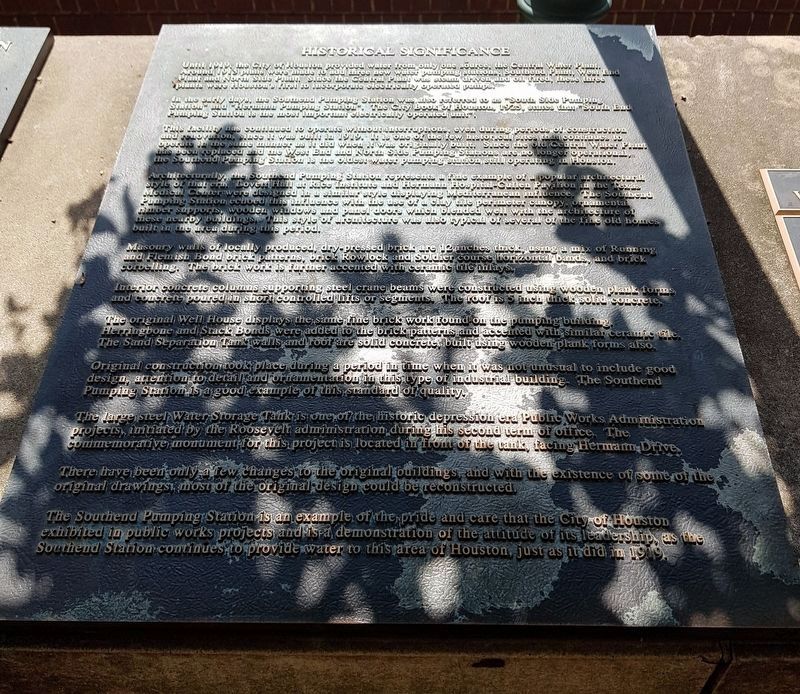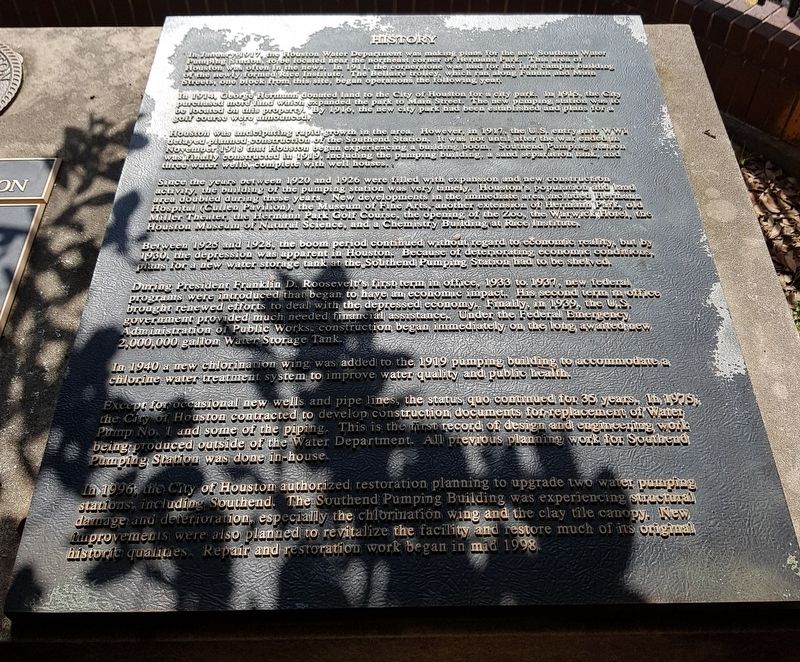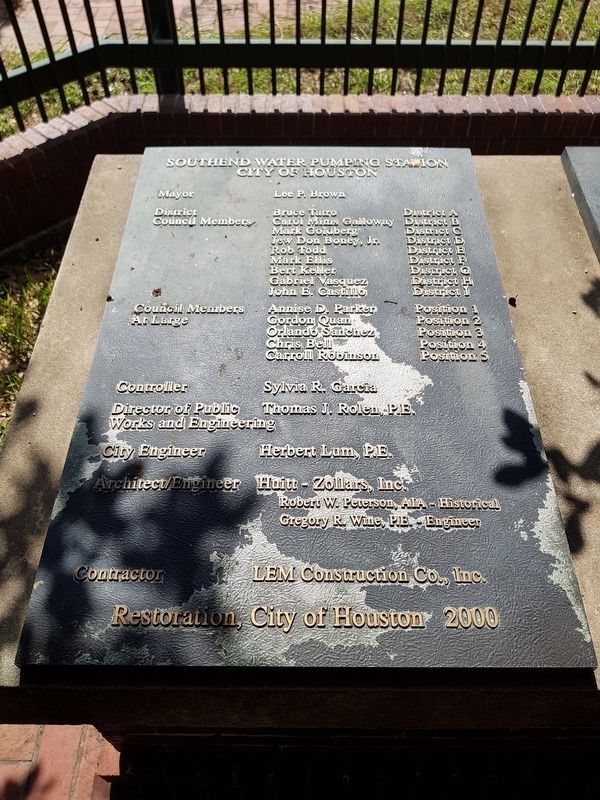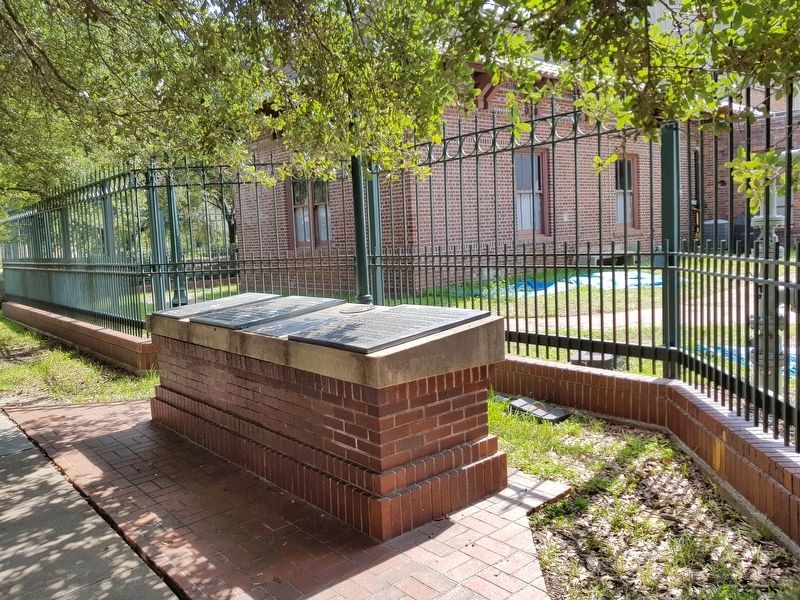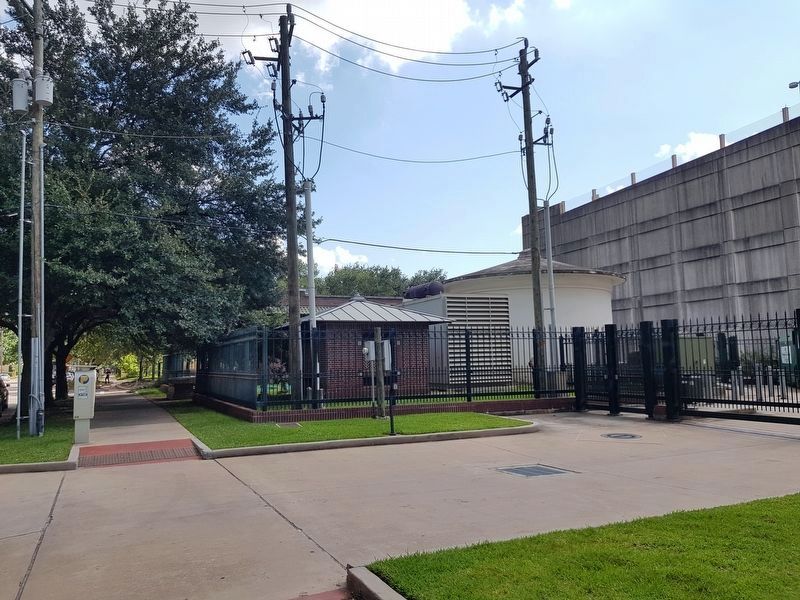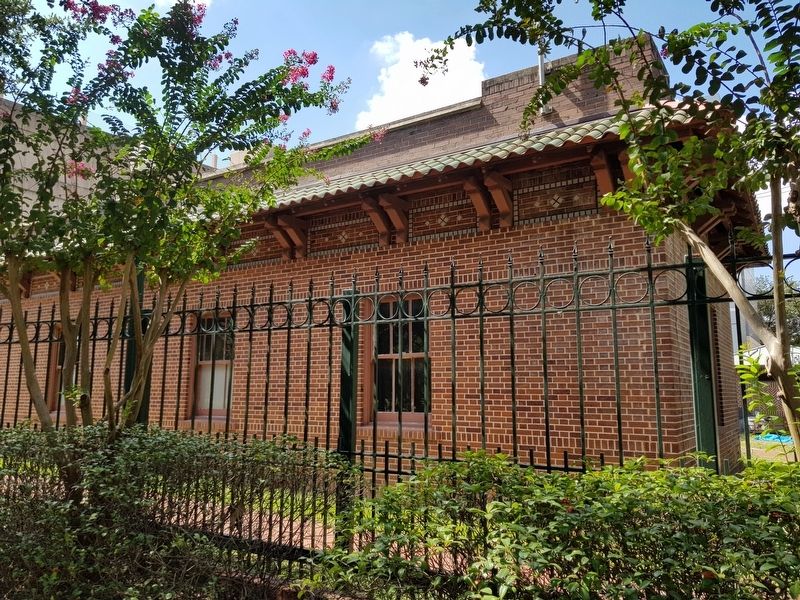Houston Museum District in Harris County, Texas — The American South (West South Central)
Southend Water Pumping Station
Inscription.
Southend Water Pumping Station
City of Houston
Historical Significance
Until 1919, the City of Houston provided water from only one source, the Central Water Plant. Around 1915 plans were made to add three new water pumping stations: Southend Plant, West End Plant and North Side Plant. Since the Central Plant was steam driven and oil fired, these three plants were Houston’s first to incorporate electricity operated pumps.
In the early days, the Southend Pumping Station was also referred to as “South Side Pumping Station” and “Hermann Pumping Station”. The City Book of Houston, 1925, states that “South End Pumping Station is the most important electrically operated unit”.
This facility has continued to operate without interruptions, even during periods of construction and renovation, since it was built in 1919. It is one of the few historical sites that continues to operate in the same manner as it did when it was originally built. Since the old Central Water Pump has been replaced and the West End and North Side Pumping Stations are no longer operation, the Southend Pumping Station is the oldest water pumping station still operating in Houston.
Architecturally, the Southend Pumping Station represents a fine example of a popular architectural style of that era. Lovett Hall at Rice University Institute and Hermann Hospital-Cullen Pavilion in the Texas Medical Center were designed in a similar style displaying Mediterranean influence. The Southend Pumping Station echoed this influence with the use of a clay tile perimeter canopy, ornamental timber supports, wooden windows and panel doors which blended well with the architecture of these nearby buildings. This style of architecture was also typical of several of the fine old homes built in the area during this period.
Masonry walls of locally produced, dry-pressed brick are 12 inches thick, using a mix of Running and Flemish Bond brick patterns, brick Rowlock and Soldier course horizontal bands, and brick corbelling. The brick work is further accented with ceramic tile inlays.
Interior concrete columns supporting steel crane beams were constructed using wooden plank forms and concrete poured in short controlled lifts or segments. The roof is 5 inch thick solid concrete.
The original Well House displays the same fine brick work found on the pumping building. Herringbone and Stack Bonds were added to the brick patterns and accented with similar ceramic tile. The Sand Separation Tank walls and roof are solid concrete, built using wooden plank forms also.
Original construction took place during a period in time when it was not unusual to include good
design, attention to detail and ornamentation in this type of industrial building. The Southend Pumping Station is a good example of this standard of quality.
The large steel Water Storage Tank is one of the historic depression era Public Works Administration projects, initiated by the Roosevelt administration during his second term of office. The commemorative monument for this project is located in front of the tank, facing Hermann Drive.
There have been only a few changes to the original buildings, and with the existence of some of the original drawings, most of the original design could be reconstructed.
The Southend Pumping Station is an example of the pride and care that the City of Houston exhibited in public works projects and is a demonstration of the attitude of its leadership, as the Southend Station continues to provide water to this area of Houston, just as it did in 1919.
History
In January 1917, the Houston Water Department was making plans for the new Southend Water Pumping Station, to be located near the northeast corner of Hermann Park. This area of Houston was often in the news. In 1911, the cornerstone was laid for the first campus building of the newly formed Rice Institute. The Bellaire trolley, which ran along Fannin and Main Streets, one block from this site, began operations the following year.
In 1914, George Hermann
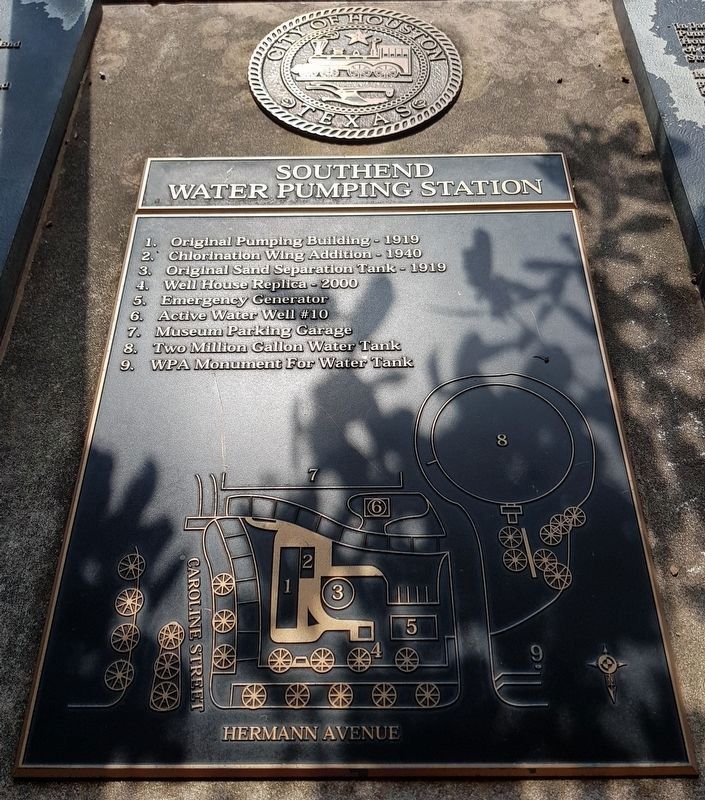
Photographed By J. Makali Bruton, October 6, 2019
3. Southend Water Pumping Station Marker map
Southend Water Pumping Station
1. Original Pumping Building – 1919
2. Chlorination Wing Addition – 1940
3. Original Sand Separation Tank – 1919
4. Well House Replica – 2000
5. Emergency Generator
6. Active Water Well #10
7. Museum Parking Garage
8. Two Million Gallon Water Tank
9. WPA Monument For Water Tank
1. Original Pumping Building – 1919
2. Chlorination Wing Addition – 1940
3. Original Sand Separation Tank – 1919
4. Well House Replica – 2000
5. Emergency Generator
6. Active Water Well #10
7. Museum Parking Garage
8. Two Million Gallon Water Tank
9. WPA Monument For Water Tank
Houston was anticipating rapid growth in the area. However, in 1917, the U.S. entry into WWI delayed planned construction of the Southend Station. It was not until after the war ended in November 1918 that Houston began experiencing a building boom. Southend Pumping Station was finally constructed in 1919, including the pumping building, a sand separation tank, and three water wells, complete with well houses.
Since the years between 1920 and 1926 were filled with expansion and new construction activity, the building of the pumping station was very timely. Houston’s population and land area doubled during these years. New developments in the immediate area included Hermann Hospital (Cullen Pavilion), the Museum of Fine Arts, another extension of Hermann Park, old Miller Theater, the Hermann Park Golf Course, the opening of the Zoo, the Warwick Hotel, the Houston Museum of Natural Science, and a Chemistry Building at Rice Institute.
Between 1925 and 1928, the boom period continued without regard to economic reality, but by 1930, the depression was apparent in Houston. Because of
deteriorating economic conditions, plans for a new water storage tank at the Southend Pumping Station had to be shelved.
During Franklin D. Roosevelt’s first term in office, 1933 to 1937, new federal programs were introduced that began to have an economic impact. His second term in office brought renewed efforts to deal with the depressed economy. Finally, in 1939, the U.S. government provided much needed financial assistance. Under the Federal Emergency Administration of Public Works, construction began immediately on the long awaited new 2,000,000 gallon Water Storage Tank.
In 1940 a new chlorination wing was added to the 1919 pumping building to accommodate a chlorine water treatment system to improve water quality and public health.
Except for occasional new wells and pipe lines, the status quo continued for 35 years. In 1974, the City of Houston contracted to develop construction documents for replacement of Water Pump No. I and some of the piping. This is the first record of design and engineering work being produced outside of the Water Department. All previous planning work for Southend Pumping Station was done in-house.
In 1996, the City of Houston authorized restoration planning to upgrade two water pumping stations, including Southend. The Southend Pumping Building was experiencing structural damage and deterioration, especially the chlorination
wing and the clay tile canopy. New improvements were also planned to revitalize the facility and restore much of its original historic qualities. Repair and restoration work began in mid 1998.
Erected 2000 by City of Houston.
Topics. This historical marker is listed in these topic lists: Charity & Public Work • Industry & Commerce • Parks & Recreational Areas. A significant historical month for this entry is January 1917.
Location. 29° 43.357′ N, 95° 23.323′ W. Marker is in Houston, Texas, in Harris County. It is in the Houston Museum District. Marker is on Hermann Drive north of Caroline Street, on the left when traveling west. Touch for map. Marker is in this post office area: Houston TX 77004, United States of America. Touch for directions.
Other nearby markers. At least 8 other markers are within walking distance of this marker. General Sam Houston (approx. 0.2 miles away); The Garden Club of Houston (approx. 0.2 miles away); W. L. and Susan Clayton (approx. ¼ mile away); St. Paul's United Methodist Church (approx. ¼ mile away); Clayton House (approx. ¼ mile away); First Presbyterian Church of Houston (approx. 0.3 miles away); Maurice Joseph Sullivan (approx. 0.4 miles away); Holland Lodge No. 1 (approx. half a mile away). Touch for a list and map of all markers in Houston.
Credits. This page was last revised on February 1, 2023. It was originally submitted on October 19, 2019, by J. Makali Bruton of Accra, Ghana. This page has been viewed 385 times since then and 40 times this year. Photos: 1, 2, 3, 4, 5, 6, 7. submitted on October 19, 2019, by J. Makali Bruton of Accra, Ghana.
